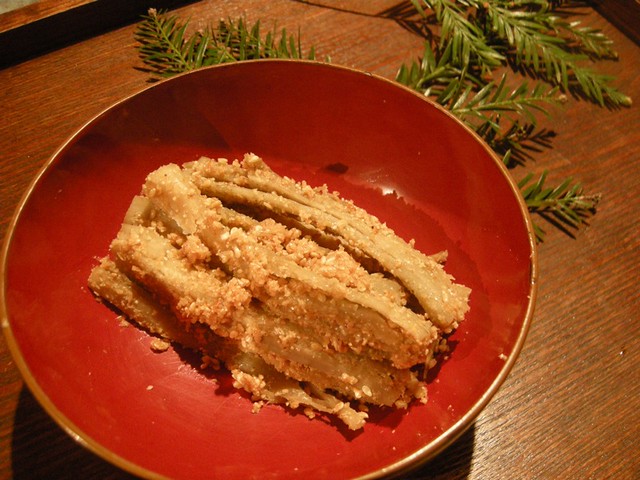
I was fortunate enough to peek into the Peko Peko kitchen this last weekend, while they were preparing all 40 boxes of their highly coveted annual
osechi bentos. What a crew! Sylvan had about five people working the kitchen -- peeling, dicing, de-shelling 40 Dungeness crabs... wow.
Sylvan and his right-hand chef Yuko took me through one of the dishes in the bento,
tataki gobo.
Tataku means "to strike" in Japanese, and that is exactly what we did to the very tough
gobo (burdock root). Then, we simmered it and dressed it in a sesame-vinegar sauce.
Gobo is eaten on New Year's Day, to symbolize deep roots, hence, stability, long life and perseverance. With
gobo popping up on many menus in the Bay Area these days, I thought this would be a great recipe to have on Umamimart.
INGREDIENTS
1 gobo root
5 cups dashi
6 tbsp mirin
6 tbsp soy sauce
Dressing
2/3 cup white toasted sesame
3 tbsp sugar
2 tbsp
usukuchi shoyu (light soy sauce)
3 tbsp rice vinegar
METHOD
1. Peel
gobo and soak in water. This is to keep it from discoloring.
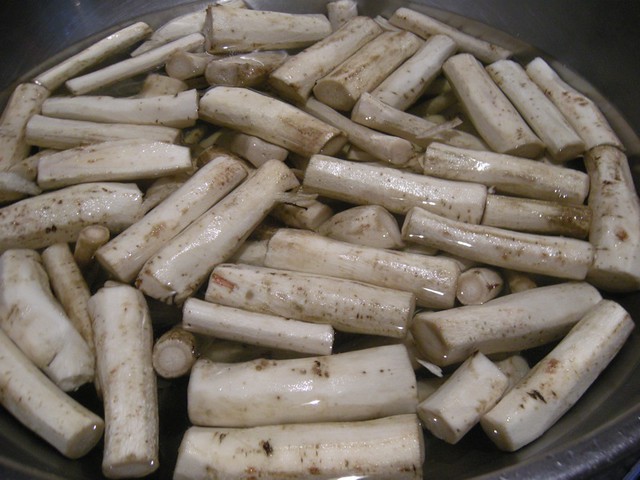
2. Strike the gobo with a heavy object.
http://www.youtube.com/watch?v=uRV8H-0c9xo&context=C3660394ADOEgsToPDskKpo9kw4PRfbeoxRDjBXDam
3. Make dashi.
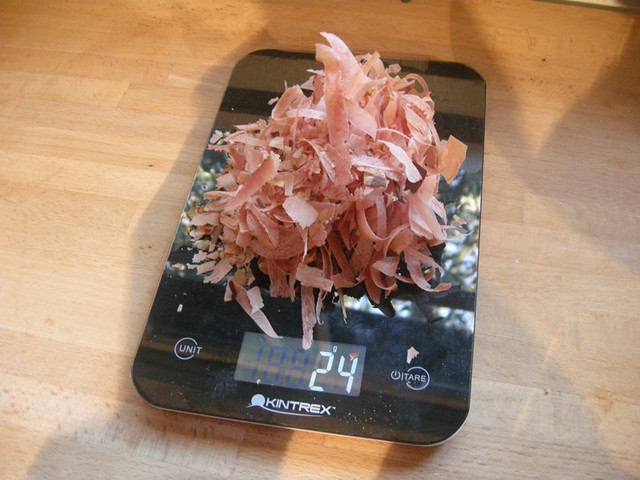
"
In Sylvan's kitchen, we use freshly shaven bonito.
 Briefly boil bonito in water
Briefly boil bonito in water
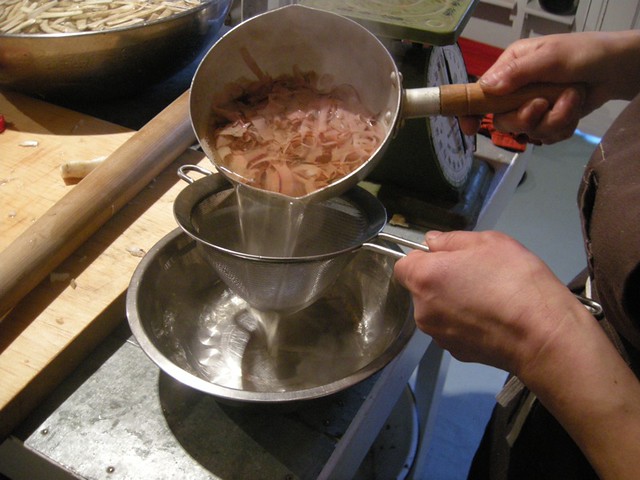 Strain
Strain
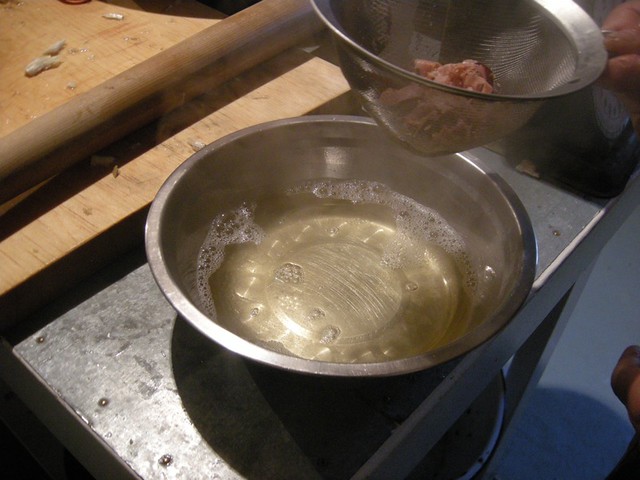
Make your own dashi using Yoko's
definitive Japanify guide.
4. Meanwhile, put
gobo in water and vinegar for 3-4 minutes to get rid of the
aku (scum) and keep it from discoloring
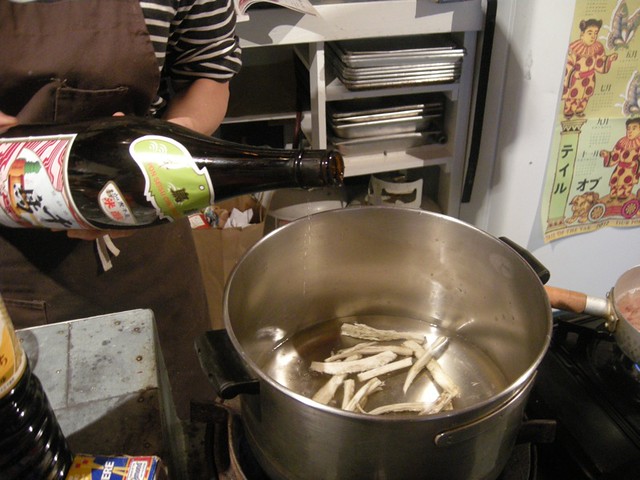
5. Add soy sauce to the dashi
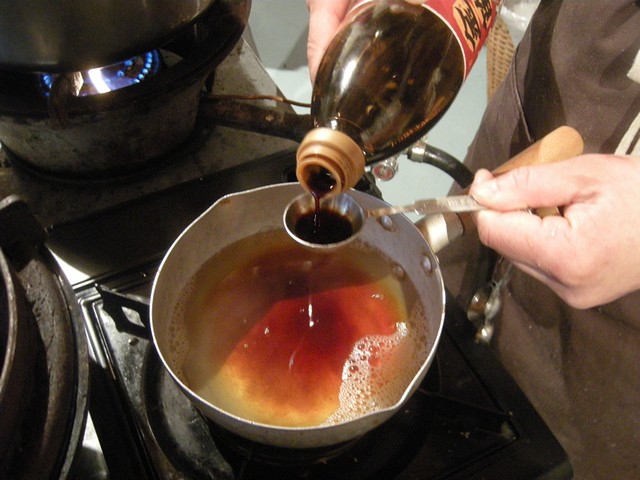
6. Strain
gobo from the vinegar, and put into the dashi mixture, and add mirin

Put the gobo on low heat for about 30 minutes. If you can, use a wide pan so it sucks up much of the liquid. You can even use a drop-lid or make one with foil. Turn off the heat after 30 minutes and let the gobo cool down.
7. For the dressing, use a
suribachi if you have one, to grind the sesame (if not, just grind sesame separately).
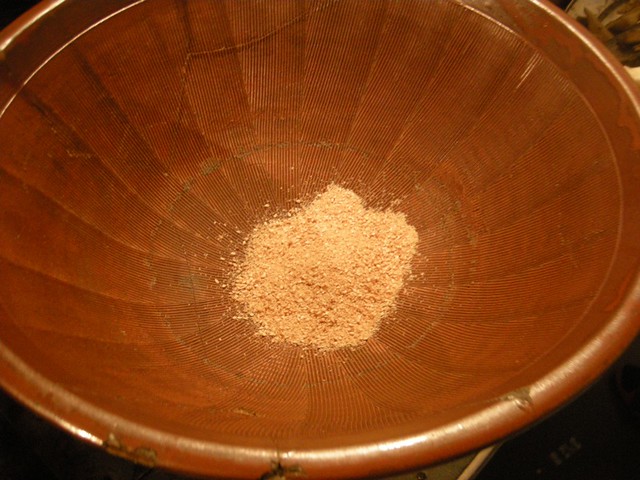
8. Add sugar.
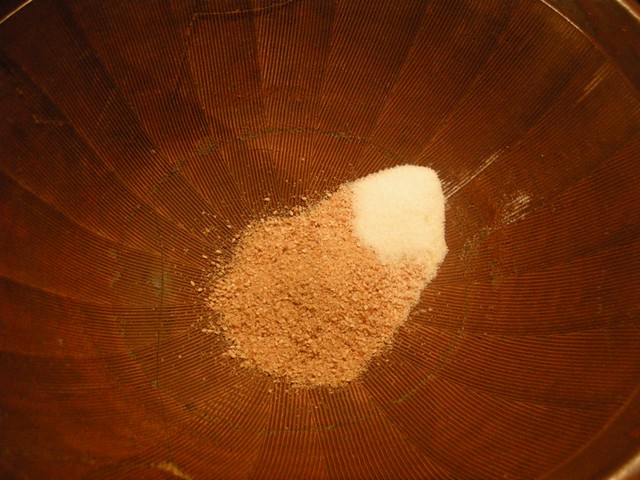
9. Grind together
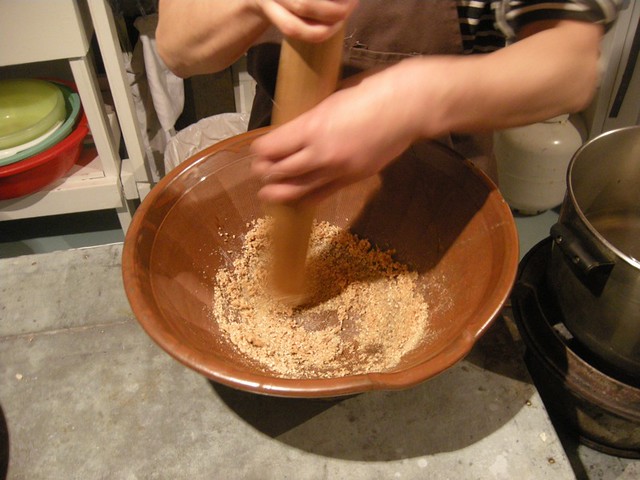
10. Add the soy sauce and vinegar. Mix together.
 Should be wet and sticky
Should be wet and sticky
10. Add the
gobo, once it has cooled. The
gobo should have a nice crisp to it.
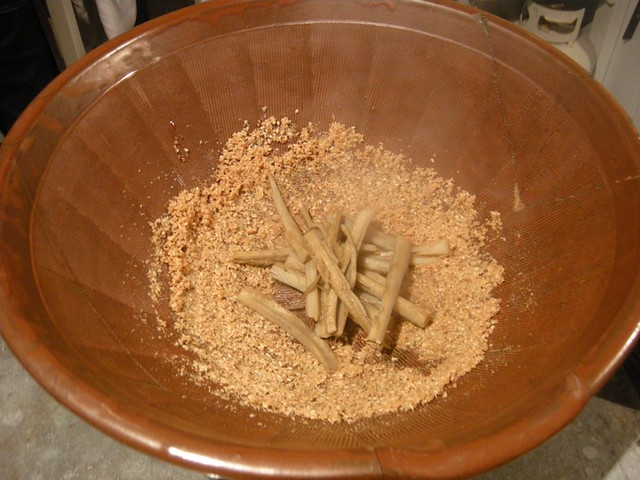
11. Mix lightly with a paddle
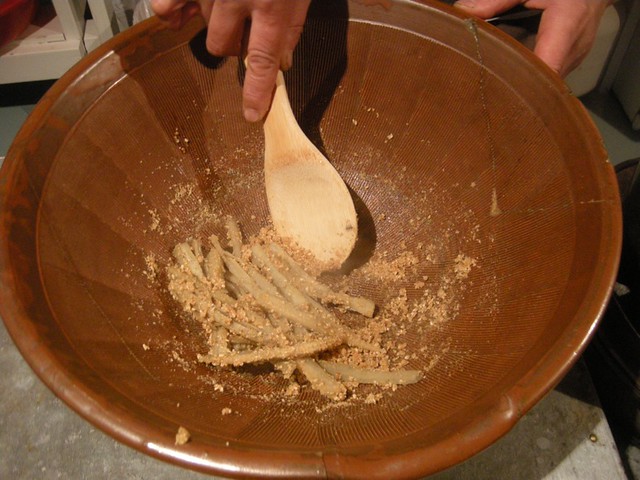 Make sure the dressing covers the gobo liberally
Make sure the dressing covers the gobo liberally
12. Plate!

Gobo is full of fiber, and this is a fantastic, simple way to prepare the tough root vegetable. I love the tartness from the vinegar married with the sweetness.
But the
gobo dish was only one of the many dishes that the Peko Peko crew prepared for the osechi bento.
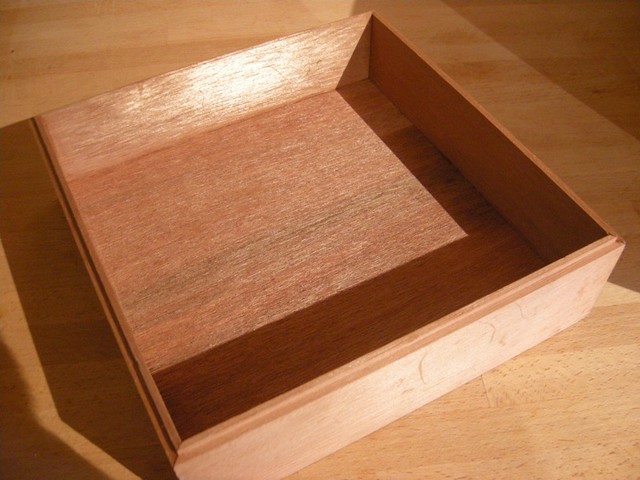 The bentos would be stacked in three tiers, in cedar boxes hand-made by Sylvan
The bentos would be stacked in three tiers, in cedar boxes hand-made by Sylvan
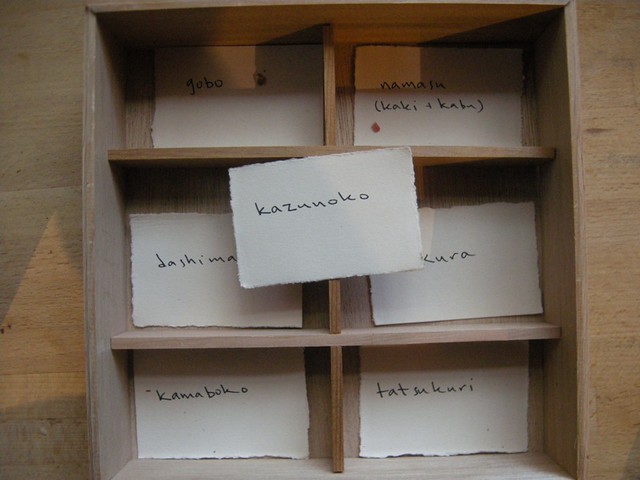 Sylvan's master plan
Sylvan's master plan
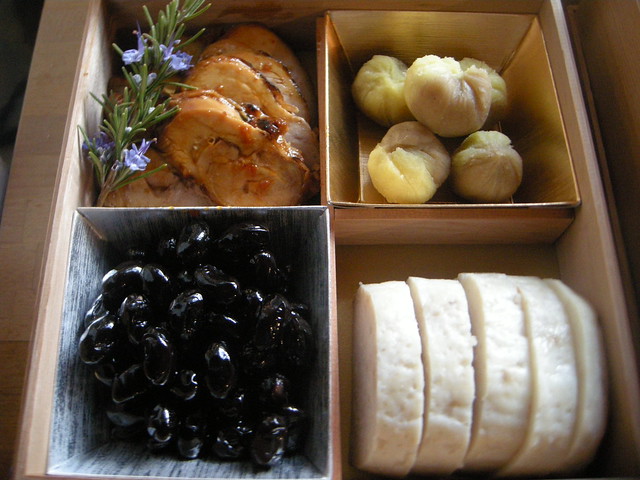
Clockwise from top left: grilled pork in orange marmalade, kurkinton (chestnut + sweet potato mash), homemade kamaboko (fishcake) with fresh wasabi, kuromame (black beans)
Sylvan somehow wrangled up some perfect, fresh wasabi roots from Oregon. Each bento got one, as garnish for the kamaboko.
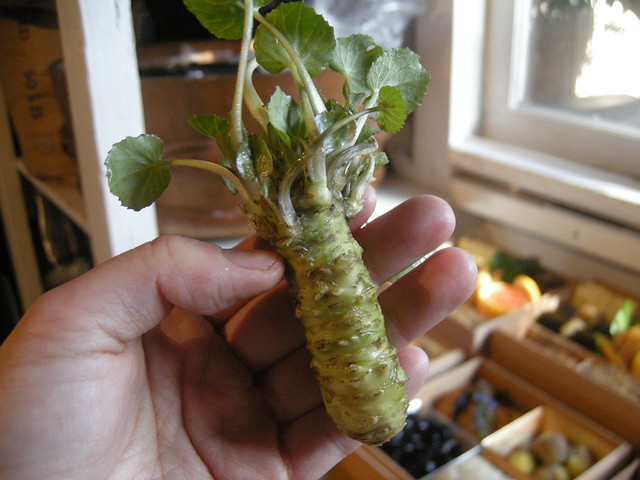
WOWWWWWWWW!!!
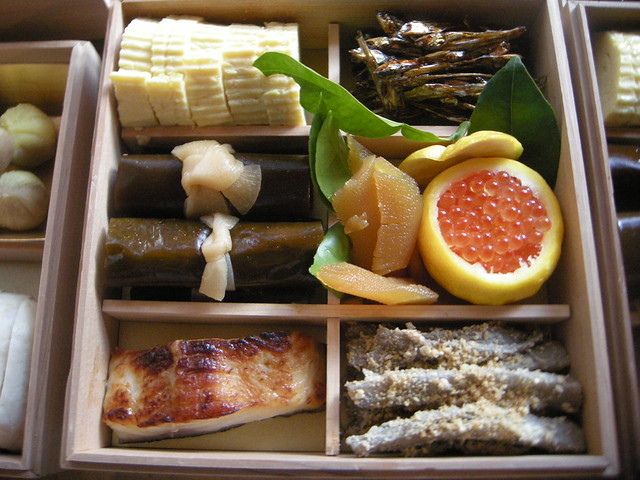 Clockwise from top left: dashimaki tamago (egg omelette), tatuskuri (candied toasted anchovies), steelhead roe in a yuzu cup and kazunoko (herring roe), tataki gobo, gindara no kasuzuke (black cod marinated in sake lees), kombumaki (kombu roll).
Clockwise from top left: dashimaki tamago (egg omelette), tatuskuri (candied toasted anchovies), steelhead roe in a yuzu cup and kazunoko (herring roe), tataki gobo, gindara no kasuzuke (black cod marinated in sake lees), kombumaki (kombu roll).
And the main event...
 Photo by Yuko Sato
Photo by Yuko Sato
All the crab meat had been pre-picked, then mixed with
namasu (daikon, carrot, persimmon vinegar salad). It was very impressive.
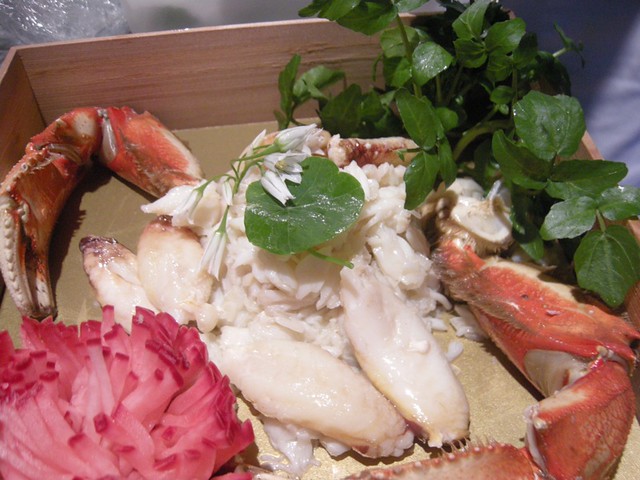 A nice, abundant surprise under the crabface.
A nice, abundant surprise under the crabface.
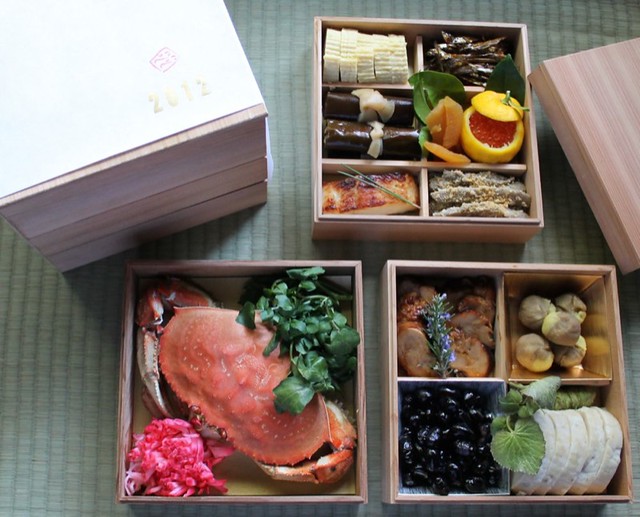 Gorgeous! Photo by Yuko Sato
Gorgeous! Photo by Yuko Sato
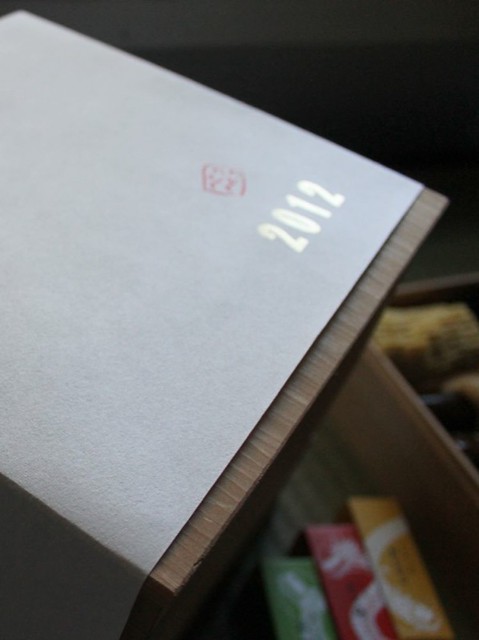 Photo by Yuko Sato
Photo by Yuko Sato
Happy 2012 to all!
 I was fortunate enough to peek into the Peko Peko kitchen this last weekend, while they were preparing all 40 boxes of their highly coveted annual osechi bentos. What a crew! Sylvan had about five people working the kitchen -- peeling, dicing, de-shelling 40 Dungeness crabs... wow.
Sylvan and his right-hand chef Yuko took me through one of the dishes in the bento, tataki gobo. Tataku means "to strike" in Japanese, and that is exactly what we did to the very tough gobo (burdock root). Then, we simmered it and dressed it in a sesame-vinegar sauce.
Gobo is eaten on New Year's Day, to symbolize deep roots, hence, stability, long life and perseverance. With gobo popping up on many menus in the Bay Area these days, I thought this would be a great recipe to have on Umamimart.
INGREDIENTS
1 gobo root
5 cups dashi
6 tbsp mirin
6 tbsp soy sauce
Dressing
2/3 cup white toasted sesame
3 tbsp sugar
2 tbsp usukuchi shoyu (light soy sauce)
3 tbsp rice vinegar
METHOD
1. Peel gobo and soak in water. This is to keep it from discoloring.
I was fortunate enough to peek into the Peko Peko kitchen this last weekend, while they were preparing all 40 boxes of their highly coveted annual osechi bentos. What a crew! Sylvan had about five people working the kitchen -- peeling, dicing, de-shelling 40 Dungeness crabs... wow.
Sylvan and his right-hand chef Yuko took me through one of the dishes in the bento, tataki gobo. Tataku means "to strike" in Japanese, and that is exactly what we did to the very tough gobo (burdock root). Then, we simmered it and dressed it in a sesame-vinegar sauce.
Gobo is eaten on New Year's Day, to symbolize deep roots, hence, stability, long life and perseverance. With gobo popping up on many menus in the Bay Area these days, I thought this would be a great recipe to have on Umamimart.
INGREDIENTS
1 gobo root
5 cups dashi
6 tbsp mirin
6 tbsp soy sauce
Dressing
2/3 cup white toasted sesame
3 tbsp sugar
2 tbsp usukuchi shoyu (light soy sauce)
3 tbsp rice vinegar
METHOD
1. Peel gobo and soak in water. This is to keep it from discoloring.
 2. Strike the gobo with a heavy object.
http://www.youtube.com/watch?v=uRV8H-0c9xo&context=C3660394ADOEgsToPDskKpo9kw4PRfbeoxRDjBXDam
3. Make dashi.
2. Strike the gobo with a heavy object.
http://www.youtube.com/watch?v=uRV8H-0c9xo&context=C3660394ADOEgsToPDskKpo9kw4PRfbeoxRDjBXDam
3. Make dashi.
 "
In Sylvan's kitchen, we use freshly shaven bonito.
"
In Sylvan's kitchen, we use freshly shaven bonito.
 Briefly boil bonito in water
Briefly boil bonito in water
 Strain
Strain
 Make your own dashi using Yoko's definitive Japanify guide.
4. Meanwhile, put gobo in water and vinegar for 3-4 minutes to get rid of the aku (scum) and keep it from discoloring
Make your own dashi using Yoko's definitive Japanify guide.
4. Meanwhile, put gobo in water and vinegar for 3-4 minutes to get rid of the aku (scum) and keep it from discoloring
 5. Add soy sauce to the dashi
5. Add soy sauce to the dashi
 6. Strain gobo from the vinegar, and put into the dashi mixture, and add mirin
6. Strain gobo from the vinegar, and put into the dashi mixture, and add mirin
 Put the gobo on low heat for about 30 minutes. If you can, use a wide pan so it sucks up much of the liquid. You can even use a drop-lid or make one with foil. Turn off the heat after 30 minutes and let the gobo cool down.
7. For the dressing, use a suribachi if you have one, to grind the sesame (if not, just grind sesame separately).
Put the gobo on low heat for about 30 minutes. If you can, use a wide pan so it sucks up much of the liquid. You can even use a drop-lid or make one with foil. Turn off the heat after 30 minutes and let the gobo cool down.
7. For the dressing, use a suribachi if you have one, to grind the sesame (if not, just grind sesame separately).
 8. Add sugar.
8. Add sugar.
 9. Grind together
9. Grind together
 10. Add the soy sauce and vinegar. Mix together.
10. Add the soy sauce and vinegar. Mix together.
 Should be wet and sticky
10. Add the gobo, once it has cooled. The gobo should have a nice crisp to it.
Should be wet and sticky
10. Add the gobo, once it has cooled. The gobo should have a nice crisp to it.
 11. Mix lightly with a paddle
11. Mix lightly with a paddle
 Make sure the dressing covers the gobo liberally
12. Plate!
Make sure the dressing covers the gobo liberally
12. Plate!
 Gobo is full of fiber, and this is a fantastic, simple way to prepare the tough root vegetable. I love the tartness from the vinegar married with the sweetness.
But the gobo dish was only one of the many dishes that the Peko Peko crew prepared for the osechi bento.
Gobo is full of fiber, and this is a fantastic, simple way to prepare the tough root vegetable. I love the tartness from the vinegar married with the sweetness.
But the gobo dish was only one of the many dishes that the Peko Peko crew prepared for the osechi bento.
 The bentos would be stacked in three tiers, in cedar boxes hand-made by Sylvan
The bentos would be stacked in three tiers, in cedar boxes hand-made by Sylvan
 Sylvan's master plan
Sylvan's master plan
 Clockwise from top left: grilled pork in orange marmalade, kurkinton (chestnut + sweet potato mash), homemade kamaboko (fishcake) with fresh wasabi, kuromame (black beans)
Sylvan somehow wrangled up some perfect, fresh wasabi roots from Oregon. Each bento got one, as garnish for the kamaboko.
Clockwise from top left: grilled pork in orange marmalade, kurkinton (chestnut + sweet potato mash), homemade kamaboko (fishcake) with fresh wasabi, kuromame (black beans)
Sylvan somehow wrangled up some perfect, fresh wasabi roots from Oregon. Each bento got one, as garnish for the kamaboko.
 WOWWWWWWWW!!!
WOWWWWWWWW!!!
 Clockwise from top left: dashimaki tamago (egg omelette), tatuskuri (candied toasted anchovies), steelhead roe in a yuzu cup and kazunoko (herring roe), tataki gobo, gindara no kasuzuke (black cod marinated in sake lees), kombumaki (kombu roll).
And the main event...
Clockwise from top left: dashimaki tamago (egg omelette), tatuskuri (candied toasted anchovies), steelhead roe in a yuzu cup and kazunoko (herring roe), tataki gobo, gindara no kasuzuke (black cod marinated in sake lees), kombumaki (kombu roll).
And the main event...
 Photo by Yuko Sato
All the crab meat had been pre-picked, then mixed with namasu (daikon, carrot, persimmon vinegar salad). It was very impressive.
Photo by Yuko Sato
All the crab meat had been pre-picked, then mixed with namasu (daikon, carrot, persimmon vinegar salad). It was very impressive.
 A nice, abundant surprise under the crabface.
A nice, abundant surprise under the crabface.
 Gorgeous! Photo by Yuko Sato
Gorgeous! Photo by Yuko Sato
 Photo by Yuko Sato
Happy 2012 to all!
Photo by Yuko Sato
Happy 2012 to all!




Comments (2)
Wow, those boxes are off the hook!
Are you supposed to crack open that crab’s shell and just munch away from its interiors?
I want to make this gobo dish. Is burdock root a rare root to obtain? Seems it’s only available in Copenhagen in dried tea bags from a health store…
A,
I’ve inserted a photo above to give you an idea of all the crab you get. No munching of the interiors necessary! Ha.
Gobo as dried tea bags, hrm. let me see if I can find you any dried gobo here so you can at least make kinpira.